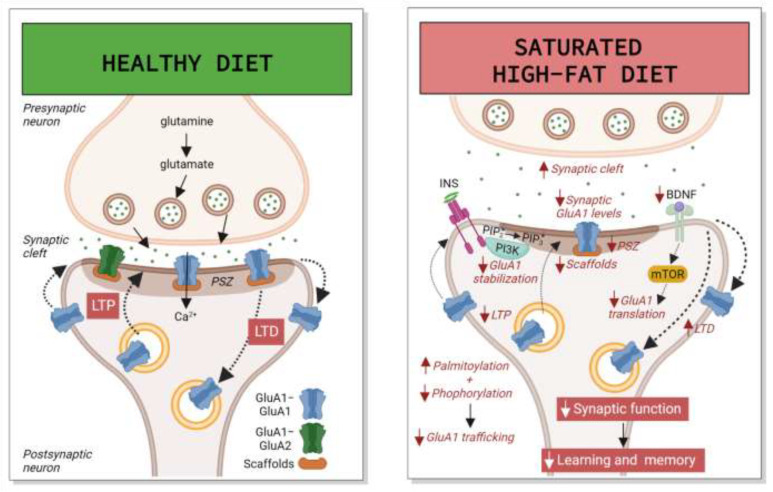Figure 1.
Mixed and saturated high-fat diet (HFD) deregulation of AMPARs in the hippocampus (HPC). In normal conditions, glutamate release induces activation of ionotropic α-amino-3-hydroxy-5-methyl-4-isoxazolepropionic acid receptors (AMPARs), both GluA1-GluA1 homomers and GluA1-GluA2 heteromers, which mediate fast excitatory synaptic transmission. Under neuroplasticity paradigms like long-term potentiation (LTP) and long-term depression (LTD), AMPAR levels in the post-synaptic zone (PSZ) increase or decrease by exocytosis or endocytosis, respectively, or through changes in their lateral diffusion, mainly controlled by phosphorylation and dephosphorylation. An intake of saturated HFD decreases LTP, enhances LTD, and reduces total GluA2 and synaptic GluA1 levels. This decrease in GluA1 may be a consequence of increased palmytoilation mediated by palmitic acid (PA) and insulin (INS) and decreased phosphorylation, and by a decline in the levels of auxiliary and scaffold proteins. All these processes may impair trafficking of GluA1 towards the plasma membrane (PM). Moreover, PA-induced phosphorylation of PI(4,5)P2 (also called PIP2) by phosphoinositide 3-kinase (PI3K), a protein kinase activated by INS, may compromise surface GluA1 stabilization, and decayed GluA1 synthesis, mediated by brain-derived neurotrophic factor (BDNF) through the mammalian target of rapamycin (mTOR), may downregulate both total and synaptic levels. Altogether, the outcome is synaptic dysfunction and learning and memory impairment. Other figure abbreviations are as follows: Ca2+: calcium ion; PIP2: phosphatidylinositol (4,5)-bisphosphate; PIP3: phosphatidylinositol (3,4,5)-trisphosphate. Image created with Biorender.com.

